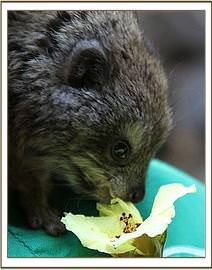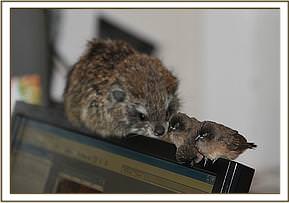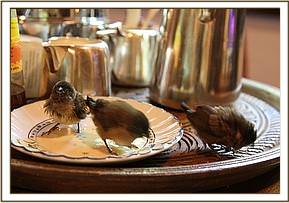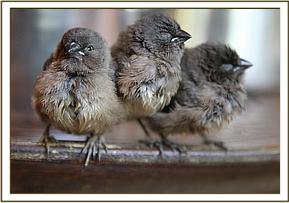The Nairobi Nursery is not just home to orphaned elephants and Rhinos but any animal that finds itself sick, injured or abandoned
The Nairobi Nursery is not just home to orphaned elephants and Rhinos but any animal that finds itself sick, injured or abandoned. Over the years the Trust has saved and successfully hand-reared a menagerie of creatures all with their own story. The beginning of 2012 has brought a few new unlikely orphans to the Nursery and these are their stories:
Rax (aka Oomph)
Just days into the New Year two tiny new-born tree hyraxes were discovered seemingly abandoned by Roan Carr-Hartley in the nursery gardens, one with her umbilical cord still attached and the other prematurely born and half the size of her sibling. All the Trust’s team were put on alert to find the missing parents amongst the numerous families inhabiting the trees around the Nursery, yet all mothers that were found already had their hands full with babies of their own. Without any other home to go to, the hyraxes were embraced by their human family. Sadly and not unexpectedly the premature female died soon after she was found, unable to survive without the strength and size that her sister had. Yet ‘Rax’ or ‘Oomph’ as she is lovingly called is now a couple of weeks old and thriving.
Oomph is actually very distantly related to the African elephant, a relationship stemming from their remote sea cow ancestors, sharing various biological similarities in teeth and leg and foot bones. Fossil remains also indicate that there were once hyraxes the size of oxen, which may explain its gestation period of 7 or 8 months, unusually long for an animal of its size.


Just like elephants these affectionate little creatures are milk-dependant, so a soya milk mixture is whipped-up for her throughout the day and night supplemented with fresh fruits and berries, lettuce, carrots, shoots and his favourite treat – geraniums. Every day Oomph departs on a morning saunter accompanied by one of her human family, where she gets to scramble up and down the garden’s thorn-trees before returning to the house for some milk, fruit and a siesta in the snuggest place she can find or on an obliging shoulder. She snoozes throughout the day and night and is a real creature of leisure. At this tender age Oomph has yet to discover her vocals and the inharmonious shrieking at night, which is notorious of tree hyraxes after a few months of age.
The future for little Oomph is bright. Hyraxes, again like elephants, have a genetic memory and have a much simpler time of reintegrating back into the wild, meeting mates and having babies. This process is made even smoother with the safe environment of the Nursery on their doorstep and the many resident hyraxes living in the surrounding trees. Should Oomph’s mother ever return for her ‘out of the blue’, which they have been known to do, she will naturally join her hyrax-family whilst still keeping in contact with her human friends; yet should she remain an orphan she will continue to be hand-reared until she is no longer milk-dependant and will continue to be fed until the day comes when she decides to ‘fly the nest’ and make a family for herself.

Romulus, Remus and Goliath
Not long after the discovery of Rax the Hyrax, the elephant orphans were charging through the bush of the Nairobi Nursery keen to be first to get to their milk, whilst unbeknownst to the greedy stampede and their Keepers, huddled on the ground were three tiny Bronze Mannikins no bigger than your thumb. These are small gregarious ‘perching birds’ and can be classified as being from the weaver-finch family and are abundant in most of Africa south of the Sahara Desert. Hardly a feather between them these newly born chicks were just days old; the Keepers could find no sign of their parents or their nest and were quite amazed at how they survived from being crushed by thundering elephant feet. Gently cupping the tiny birds in one hand they were brought to Angela’s house for some tender-loving-care, whilst a recycled nest was found and a warm and cosy box was set-up for them with a soft cuddly toy for extra warmth.
Ten days later the little Mannikins are quite the trio and are much loved by the team. Two were named Romulus and Remus and the third was called Goliath. Goliath was obviously the runt of the nest and got a hard time from his playful brothers who insisted on jumping on him constantly. With this bullying recognised, extra affection and food was lavished on Goliath who is now living up to his name and has grown just as robust as his siblings. They are fed throughout the day on crushed millet seed mixed with a little water offered on a thin kebab stick, which all the chicks eagerly await and get very excited about; they have also recently found a love for very milky sugary tea.


After over a week in their human family the chicks are already flying, loving their strolls around the garden and enjoying riding on the back of Rax, who promptly bucks them off with indignation. Hopping onto heads and shoulders they catapult themselves into the air and twitter enthusiastically for their next feed, whilst dozing regularly in snug places in the office. Unlike elephants and hyraxes with their genetic memory, birds imprint, only recognising their guardian, whether human or animal, as the parent. For this reason it is very difficult to rehabilitate birds back into the wild yet Romulus, Remus and Goliath will continue to be hand-fed and looked after until the day comes when they feel strong enough to fly from their human nest, hopefully staying close to the Nursery and the people that reared them.

